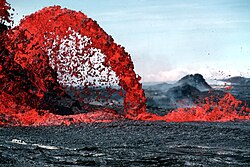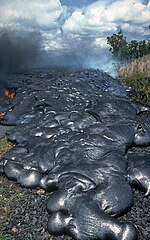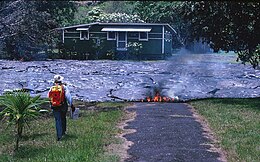Lava
Lava is molten rock expelled by a volcano during an eruption. Magma is molten rock below the earth's surface. Lava, when first exuded from a volcanic vent, is a liquid at temperatures from 700 °C to 1,200 °C (1,300 °F to 2,200 °F). Although lava is quite viscous, about 100,000 times the viscosity of water, it can flow great distances before cooling and solidifying.
Lava solidifies to form igneous rock. The term "lava flow" refers to the hardened formation, whereas the one still having molten rock associated, is called an "active lava flow". The word 'lava' comes from Italian, and is probably derived from the Latin word labes which means a fall, slide, or sinking in. The first use in connection with extruded magma was apparently in a short account written by Francesco Serao [[1]][[2] on the eruption of Vesuvius between May 14 and June 4, 1737. Serao described "a flow of fiery lava" as an analogy to the flow of water and mud down the flanks of the volcano following heavy rain.

Lava composition
In general, a lava's composition determines its behavior more than the temperature of its eruption. Igneous rocks, which form lava flows when erupted, can be classified into three chemical types; felsic, intermediate, and mafic. These classes are primarily chemical; however, the chemistry of a lava also tends to correlate with the magma temperature, its viscosity and its mode of eruption.
Felsic lavas such as rhyolite and dacite are often associated with strombolian eruptions, typically form lava domes and sheeted flows, and are associated with pyroclastic surge deposits and tuffs. Felsic lavas are extremely viscous. This is caused primarily by the chemistry of the magma, which is high in silica, aluminium, potassium, sodium, and calcium, forming a polymerized liquid rich in feldspar and quartz, which is thus much more sticky than other magma types. Felsic magmas can erupt at temperatures as low as 650 to 750 degrees Celsius, although they can be hotter.
Intermediate lavas are lower in aluminium and silica, and usually somewhat richer in magnesium and iron. Intermediate lavas form andesite domes and sheeted flows, are usually associated with strombolian eruptions, and form composite volcanoes. Poorer in aluminium and silica than felsic lavas, and also hotter (in the range of 750 to 950 degrees Celsius), they tend to be less viscous. Greater temperatures tend to destroy polymerized bonds within the magma, promoting more fluid behaviour and also a greater tendency to form phenocrysts. Higher iron and magnesium tends to manifest as a darker groundmass, and also occasionally amphibole or pyroxene phenocrysts.
Mafic lavas are typified by their high basalt content, which generally erupts at temperatures in excess of 950 degrees Celsius. Basaltic magma is high in iron and magnesium, and has relatively lower aluminium and silica, which taken together reduces the degree of polymerization within the melt. Due to the higher temperatures, viscosities can be relatively low, although still thousands of times more viscous than water. The low degree of polymerization and high temperature favors chemical diffusion, so it is common to see large, well-formed phenocrysts within mafic lavas. Basalt volcanoes tend to form shield volcanoes, as the fluid magma tends to form thin, widely distributed flows.
Ultramafic lavas such as komatiite and high-magnesian magmas which form boninite take the composition and temperatures of eruptions to the extreme. Komatiites contain over 18% magnesium oxide, and are thought to have erupted at temperatures of 1600 °C. At this temperature there is no polymerization of the mineral compounds, creating a highly mobile liquid with viscosity as low as that of water. Most if not all ultramafic lavas are no younger than the Proterozoic, with a few ultramafic magmas known from the Phanerozoic. No modern komatiite lavas are known, as the Earth's mantle has cooled too much to produce highly magnesian magmas.
Lava behaviour
The viscosity [3] of lava is important because it determines how the lava will behave.
Highly viscous lava shows the following behaviors:
- It tends to flow slowly, clog, and form semi-solid blocks which resist flow
- It tends to entrap gasses, which form bubbles within the rock as they rise to the surface
- It correlates with explosive or phreatic eruptions and is associated with tuff and pyroclastic flows
Highly viscous lavas do not usually flow as liquid, and usually form explosive fragmental ash and cinder deposits. However, a degassed viscous lava or one which erupts somewhat hotter than usual may form a lava flow. Viscous lavas have two forms of non-pyroclastic eruptions, lava domes and sheeted flows.
Lava with low viscosity shows the following behaviors:
- It tends to flow easily, forming puddles, channels, and rivers of molten rock
- It tends to easily release bubbling gases as they are formed
- Eruptions are rarely pyroclastic and are usually quiescent
- Volcanoes tend to form as rifts, not steep cones
There are three forms of low-viscosity lava flows: 'a'ā, pāhoehoe, and pillow lava. They are described in the following sections.
Of course, lavas also may contain many other components, sometimes including solid crystals of various minerals, fragments of exotic rocks known as xenoliths and parts of its own solidified lava products.
Lava domes

Cooling viscous lava often clogs a volcanic vent, allowing pressure behind the blockage to build; trapped gasses within the lava also add to the pressure, eventually producing cataclysmic explosions, ejecting great clouds of volcanic ash and gas, and producing pyroclastic flows. Most explosive eruptions tend to be followed by a quieter period of lava extrusion.
Sometimes as a volcano extrudes silicic lava, it forms an inflation dome, gradually building up a large, pillow-like structure which cracks, fissures, and may release cooled chunks of rock and rubble. The top and side margins of an inflating lava dome tend to be covered in fragments of rock., breccia and ash.
Examples of lava dome eruptions include the Novarupta dome, and successive lava domes of Mount St Helens.
Sheeted flows
Sheeted flows are an uncommon form of eruptive phenomena of felsic and intermediate volcanoes. Internal pressure of gases tend to promote pyroclastic and explosive eruptions. However, a viscous magma will flow, though very slowly, across the surface of the Earth.
Typically the lava flow forms a sheeted flow or laminar flow, with the upper and lower margins of the flowing lava forming a hard, brittle shell inside of which the sticky, viscous lava will be flowing. The hard skin forms a chaotic igneous breccia called autobreccia, as the flow creeps along, churning the outer margins apart. This is similar to an ʻaʻā flow except that the inner lava will show evidence of stretching, plastic deformation and even foliation of the highly viscous lava.
Examples of laminar or sheeted flows include the Tertiary aged volcanic edifices of the Glasshouse mountains, and the cliffs of Kangaroo Point in Brisbane, Australia.
'A'ā
'A'ā (Hawaiian English, from Hawaiian meaning "stony with rough lava", but also to "burn" or "blaze") is one of three basic types of flow lava. 'A'ā is characterized by a rough or rubbly surface composed of broken lava blocks called clinker.
The loose, broken, and sharp, spiny surface of a solidified 'a'ā flow makes walking difficult and slow. The clinkery surface actually covers a massive dense core, which was the most active part of the flow. As pasty lava in the core travels downslope, the clinkers are carried along at the surface. At the leading edge of an 'a'ā flow, however, these cooled fragments tumble down the steep front and are buried by the advancing flow. This produces a layer of lava fragments both at the bottom and top of an 'a'ā flow. Accretionary lava balls as large as 3 m (10 ft) are common on 'a'ā flows. 'A'ā is usually of higher viscosity than pāhoehoe (usually spelled just pahoehoe). Pāhoehoe can turn into 'a'ā if it becomes turbulent due to meeting impediments or steep slopes.
The sharp, angled texture makes 'a'ā a perfect radar reflector, and can easily be seen from an orbiting satellite (bright on Magellan pictures).
Pāhoehoe

Pāhoehoe (Hawaiian English, from Hawaiian, meaning "smooth, unbroken lava") is basaltic lava that has a smooth, billowy, undulating, or ropy surface. These surface features are due to the movement of very fluid lava under a congealing surface crust. A pāhoehoe flow typically advances as a series of small lobes and toes that continually break out from a cooled crust. Also forms lava tubes where the minimal heat loss maintains low viscosity. The surface texture of pāhoehoe flows varies widely, displaying all kinds of bizarre shapes often referred to as lava sculpture. With increasing distance from the source, pāhoehoe flows may change into 'a'ā flows in response to heat loss and consequent increase in viscosity.
The rounded texture makes pāhoehoe a lousy radar reflector, and is difficult to see from an orbiting satellite (dark on Magellan pictures).
Pillow lava

Pillow lava is the rock type typically formed when lava emerges from an underwater volcanic vent or a lava flow enters the ocean. The viscous lava gains a solid crust immediately upon contact with the water, and this crust cracks and oozes additional large blobs or "pillows" as more lava emerges from the advancing flow. Since the majority of Earth's surface is covered by water, and most volcanoes are situated near or under it, pillow lava is very common.
Lava landforms
Due to being formed from viscous molten rock, lava flows and eruptions create distinctive formations, landforms and topographical features from the macroscopic to the microscopic.
There are few things not made of rock that can resist the progress of flowing lava; trees, houses, everything yields to its massive assault. Trees soon catch fire due to the heat of approaching lava, and when the lava reaches them they emit a hissing noise, almost amounting to a shriek. The trees then plunge into the molten flood and are seen no more. Even the sea cannot stop the lava-stream, but retires on its approach; promontories stretching a considerable distance from the shore are formed in this manner as the molten lava hardens into stone.
Volcanoes

Volcanoes are the primary landform created by lava eruption and consist of flattish, shallow shield volcanes formed from basalt to steeply-sided ash and lava composite volcanic cones typical of andesite and rhyolite lavas.
Volcanoes can form calderas if they are obliterated by large pyroclastic or phreatic eruptions, and such features typically include volcanic crater lakes and lava domes after the event.
Cinder and splatter cones
Cinder cones and spatter cones are small-scale features formed by lava accumulation around a small vent on a volcanic edifice. Cinder cones are formed from tephra or ash and tuff which is thrown from an explosive vent. Spatter cones are formed by accumulation of molten volcanic slag and cinders ejected in a more liquid form.
Lava domes

Lava domes are formed by the extrusion of viscous felsic magma. They can form prominent rounded protuberances, such as at Valle Calderas.
Lava tubes
Lava tubes are formed when a flow of relatively fluid lava cools on the upper surface sufficiently to form a crust. Beneath this crust, which by dint of being made of rock is an excellent insulator, the lava can continue to flow as a liquid. When this flow occurs over a prolonged period of time the lava conduit can form a tunnel-like apertre or lava tube, which can conduct molten rock many kilometres from the vent without cooling appreciably. Often these lava tubes drain out once the supply of fresh lava has stopped, leaving a considerable length of open tunnel within the lava flow.
Lava tubes are known from the modern day eruptions of Kīlauea, and significant, extensive lava tubes of Tertiary age are known from North Queensland, Australia, some extending for 15 kilometres.
Lava cascades and fountains
The eruptions of lava are sometimes attended by peculiarities which impart to them much additional grandeur. Instances have occurred in which the fiery stream has plunged over a sheer precipice of immense height, so as to produce a glowing cascade exceeding (in breadth and perpendicular descent) the celebrated Niagara Falls. In other cases, the lava, instead of at once flowing down the sides of the mountain, has been first thrown up into the air as a fiery fountain several hundred feet in height (see Volcanic cone).
Lava lakes
Rarely, a volcanic cone may fill with lava but not erupt. Lava which pools within the caldera is known as a lava lake. Lava lakes do not usually persist for long, either draining back into the magma chamber once pressure is relieved (usually by venting of gases through the caldera), or by draining via eruption of lava flows or pyroclastic explosion.
There are only a few sites in the world where permanent lakes of lava exist. These include:
- Mount Erebus, Antarctica
- Kilauea Volcano, Hawaiʻi
- Erta Ale, Ethiopia
- Nyiragongo, Democratic Republic of Congo
Composition of volcanic rocks

The sub-family of rocks which form from volcanic lava are called igneous volcanic rocks (to differentiate them from igneous rocks which form from magma, below the surface of the earth, called igneous plutonic rocks).
The lavas of different volcanoes, when cooled and hardened, differ much in their appearance and composition. If a rhyolite lava-stream cools quickly, it can quickly freeze into a black glassy substance called obsidian. When filled with bubbles of gas, the same lava may form the spongy mineral pumice. Allowed to cool slowly, it forms a light-colored, uniformly solid rock called rhyolite.
Unusual lavas
Three types of unusual volcanic rocks have been recognised as erupting onto the surface of the Earth;
- Carbonatite and natrocarbonatite lavas are known from Ol Doinyo Lengai volcano in Tanzania, which is the sole example of a carbonatite volcano.
- Sulfide lavas have been recognised from Chile and Peru
- Iron oxide lavas are thought to be the source of the iron ore at Kiruna, Sweden, erupted in the Proterozoic
Hazards
Lava flows are enormously destructive to property in their path but generally move slowly enough for people to get out of their way, so casualties caused directly by active lava flows are rare. Nevertheless injuries and deaths have occurred, either because people had their escape route cut off, because they get too close to the flow[4] or, more rarely, if the lava flow front travels too quickly.
This notably happened during the eruption of Nyiragongo in Zaire (now Democratic Republic of Congo) on 10 January 1977 when the crater wall was breached during the night and the fluid lava lake in it drained out in less than an hour. Flowing down the steep slopes of the volcano at up to 60 miles per hour (100 km per hour), the lava swiftly overwhelmed several villages whilst their residents were asleep. As a result of this disaster, the mountain was designated a Decade Volcano in 1991[5].
Deaths attributed to lava flows frequently have a different cause, for example pyroclastic flow from a collapsing lava dome, or explosions caused when the flow comes into contact with water[6].
Towns destroyed by lava flows

- Kaimū, Hawaiʻi (abandoned)
- Kalapana, Hawaiʻi (abandoned)
- Kapoho, Hawaiʻi (abandoned)
- Keawaiki, Hawaiʻi (abandoned)
- Koaʻe, Hawaiʻi (abandoned)
- San Sebastiano al Vesuvio, Italy (rebuilt)
Towns partially destroyed by lava flows
- Pompeii, Italy, in the eruption Mount Vesuvius in August 23, 79 AD
- Catania, Italy, in the eruption Mount Etna in 1669 (rebuilt)
- Goma, Democratic Republic of Congo, in the eruption of Nyiragongo in 2002
- Heimaey, Iceland, in the 1973 Eldfell eruption (rebuilt)
- Royal Gardens, Hawaiʻi, by the eruption of Kilauea in 1986-87 (abandoned)
- Paricutin (village the volcano was named after) and San Juan Parangaricutiro, Mexico, by Paricutin from 1943-1952.
